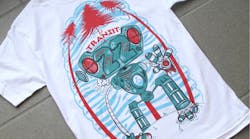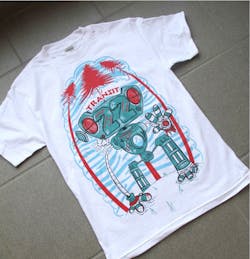One customized infrared sensor lets flash-cure systems speed up production of screen-printed tee shirts.
The sensor, called the IRt/c, is from Exergen Corp., Watertown, Mass. Several of them are used in quartz flash units from M&R Companies, Niles, Ill., said to be the world’s largest manufacturer of screen-printing equipment. The flash units, dubbed the Red Chili 1418 and the Cayenne D, can pull up to about 45 kW of power with their high-intensity, densely packed IR lamps. The closely spaced lamps restrict the view of the T-shirt area from where the sensor sits above the lamps and can heat the body of the sensor itself. The customized four-wire IRt/c sensors solve these problems by incorporating a thermocouple positioned near the head of the sensor. The thermocouple reads the temperature of the sensor body itself while the IR sensor reads the temperature of the tee shirt being cured.
In the flash-cure equipment, a controller reads the IRt/c signal at about a 20-Hz rate. The controller uses the IR sensor signal to control flash curing (typically on the order of a few seconds for a typical tee shirt). The controller uses the signal from the IRt/c’s built-in thermocouple to monitor temperatures in the sensor and predict when or if the system might overheat.
The Red Chili D quartz flash-cure device uses medium-wave sealed tungsten-filament quartz lamps. The lamps are divided into three flashing zones which can operate independently or in combination. Using fewer cure zones on small screen-print areas reduces ambient heat, lowers energy costs, and lets the substrate cool faster.
Resources: Showdown Merchandising


